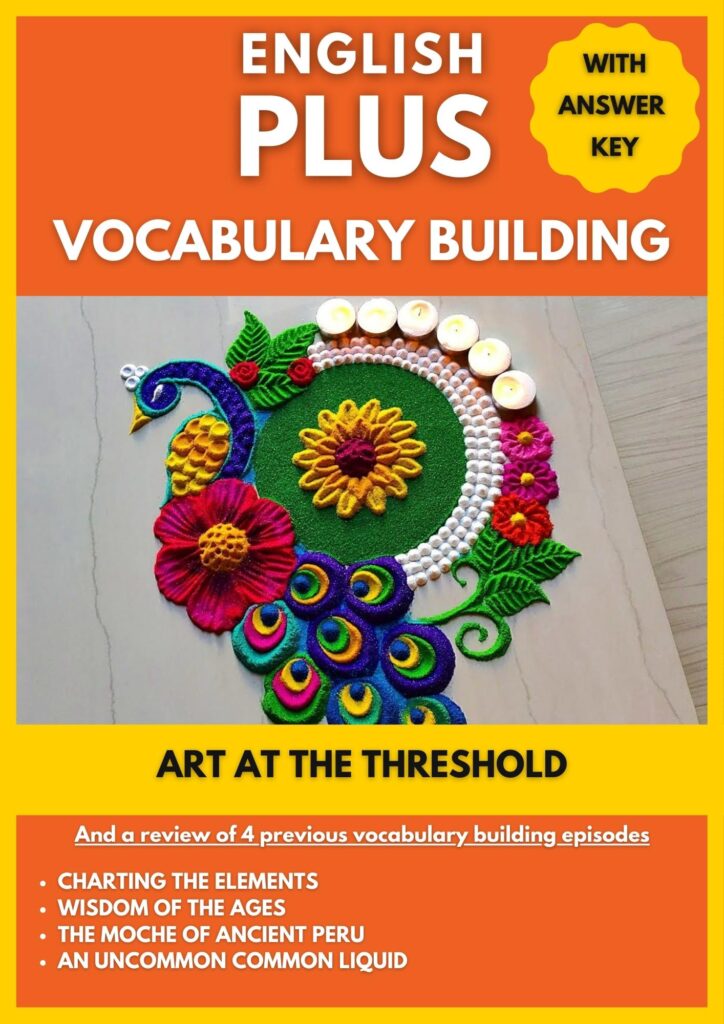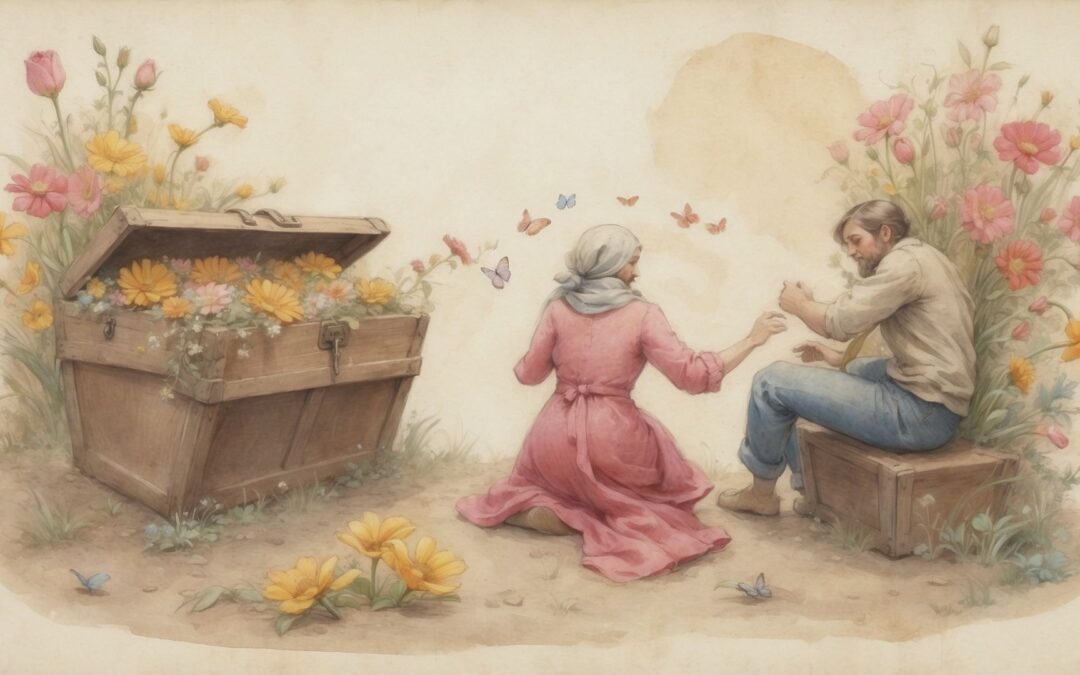Introduction
Learn about the traditional art of Rangoli, art at the threshold in this new Word Power episode from English Plus Podcast.
Interactive Transcript
Click play and see the words as you hear them. You can search for certain words and you can press on any word to start playing from there. You can choose to auto-scroll as you listen to the episode; you can find the toggle below. Enjoy 🙂
Audio Podcast
Art at the Threshold
Regardless of the culture, home is where the spirit of a people is palpable. In India, the home is almost sacrosanct, a reflection of one’s innermost person. On earthen surfaces in their native country and on the concrete doorsteps of homes in their adopted nations, Indian women carry out the ancient tradition of rangoli, decorating the threshold with turmeric, indigo, lentils, and other natural substances. These designs provide a vibrant welcome mat to even the most modest dwelling.
The exact origins of rangoli are unknown, but art historians assume that the tradition began as a form of thanksgiving. To the people of lndia, the floor is synonymous with the earth, a mother figure that supports all life. To adorn the floor of a house is to honor the house and the earth as special places. The art form has an added dimension, teaching children that beauty in the home is something that can be created easily and does not require material possessions.
While rangoli designs vary from region to region and family to family, they follow prescriptive patterns, often a series of dots or dashes aligned in the shapes of plants, animals, gods and goddesses, or geometric forms. Although thin sticks wound with cloth are sometimes used, the basic tool for rangoli is the hand. The artist begins by placing her materials in small containers with wide brims. After selecting a freshly swept spot on the floor or doorstep, she creates her designs spontaneously. She pinches a bit of powder between her forefinger and thumb, then shakes off the excess. She moves her hand to the chosen spot, slides her thumb slowly over the forefinger, which acts like a miniature shovel, and then drops off the powder carefully to make a swirling arabesque. The materials may also be sieved through a clenched fist, using fingertips to trace filigreed patterns. Lentils, grains, pebbles, and flowers are added for texture and color. The designs glow in sunlight and coruscate in reflected moonlight.
Whether an everyday routine or a celebratory ritual, rangoli turns a common floor into momentary poetry. Its fugacious nature, whereby the designs are swept away with a grass broom at day’s end (if they haven’t been trampled beforehand), emphasizes the process of creation. Once the beautiful pictures are swept away, only their specters linger in the minds of their creators.
Interactive Activities
Flashcards
Learning
Matching
Spelling
Test
Crossword Puzzle
PDF Practice Worksheet

Text Transcript
Danny:
Welcome to a new episode from English Plus Podcast. Today our episode is Word Power. We will learn about something interesting related to a specific type of traditional art in India, and then we will discuss the meaning of 10 keywords in context.
Don’t forget that you can practice what you learn on the website and make sure you make these ten words you’re going to learn in today’s episode a part of your permanent active vocabulary bank, and there’s a lot to learn on our website englishpluspodcast.com, so after you finish listening to this episode, take some time and go explore our website and I am certain you will find something interesting you will want to learn more about.
And now let’s get back to our topic for today, Art at the Threshold. We will talk about rangoli today, and we will learn 10 new words in the context of our story.
The words we will learn today are: palpable, sacrosanct, modest, adorn, prescriptive, arabesque, filigree, coruscate, fugacious and specter.
So are you ready to learn about something interesting and build your vocabulary with English Plus? Let’s get started.
I would like to welcome my good buddy, Ben who’s going to co-host this episode with me. Thank you for joining me, Ben.
Ben:
Thank you, Danny. It’s always a pleasure learning new words in the context of an interesting story. Glad to be a part of it.
Danny:
Alright then. Today, I would like to talk about a special kind of art that comes from the great country of India.
Ben:
Yes, India has a rich and diverse cultural heritage, and its art reflects that. One of the most famous forms of Indian art is Madhubani painting, also known as Mithila painting. It originated in the Mithila region of Bihar and is characterized by bold lines, vibrant colors, and intricate designs that depict nature, Hindu gods and goddesses, and everyday life. Another famous form of Indian art is Warli painting, originating from the Warli tribe in Maharashtra. It is known for its simple yet powerful imagery, depicting rural life, nature, and rituals. These are just a few examples of the rich and diverse art forms found in India.
Danny:
We will talk specifically about rangoli.
Ben:
Sure! Rangoli is a traditional Indian art form that involves creating patterns and designs on the floor using colored powders, usually made from rice flour, or flower petals. It is usually made during festivals, such as Diwali, and is believed to bring good luck and prosperity to the home. Rangoli designs can range from simple geometric shapes to more complex, intricate designs featuring gods, animals, and nature scenes. Rangoli is a popular form of folk art in India and is an important part of Indian culture, symbolizing hospitality and welcoming guests into the home.
Danny:
Can we still find rangoli in India today?
Ben:
Yes, rangoli is still a very popular form of art in India, and can be found in homes, temples, and public spaces, particularly during festivals and special occasions. It is a vibrant and colorful expression of traditional Indian culture, and continues to be practiced by many people across India. Additionally, rangoli competitions are often held, where participants create large and intricate designs, showcasing their skills and creativity. Rangoli is not just an art form, but also an important part of Indian heritage, and is treasured by many people who view it as a symbol of the country’s rich cultural heritage.
Danny:
All right, let’s start with our story about rangoli or Art at the Threshold and then we will discuss the meaning of the 10 keywords we have within this story. Shall we? Would you like to read the story for us, Ben?
Ben:
Of course! So, our story is about a traditional artform from India.
Art at the Threshold
Regardless of the culture, home is where the spirit of a people is palpable. In India, the home is almost sacrosanct, a reflection of one’s innermost person. On earthen surfaces in their native country and on the concrete doorsteps of homes in their adopted nations, Indian women carry out the ancient tradition of rangoli, decorating the threshold with turmeric, indigo, lentils, and other natural substances. These designs provide a vibrant welcome mat to even the most modest dwelling.
The exact origins of rangoli are unknown, but art historians assume that the tradition began as a form of thanksgiving. To the people of lndia, the floor is synonymous with the earth, a mother figure that supports all life. To adorn the floor of a house is to honor the house and the earth as special places. The art form has an added dimension, teaching children that beauty in the home is something that can be created easily and does not require material possessions.
While rangoli designs vary from region to region and family to family, they follow prescriptive patterns, often a series of dots or dashes aligned in the shapes of plants, animals, gods and goddesses, or geometric forms. Although thin sticks wound with cloth are sometimes used, the basic tool for rangoli is the hand. The artist begins by placing her materials in small containers with wide brims. After selecting a freshly swept spot on the floor or doorstep, she creates her designs spontaneously. She pinches a bit of powder between her forefinger and thumb, then shakes off the excess. She moves her hand to the chosen spot, slides her thumb slowly over the forefinger, which acts like a miniature shovel, and then drops off the powder carefully to make a swirling arabesque. The materials may also be sieved through a clenched fist, using fingertips to trace filigreed patterns. Lentils, grains, pebbles, and flowers are added for texture and color. The designs glow in sunlight and coruscate in reflected moonlight.
Whether an everyday routine or a celebratory ritual, rangoli turns a common floor into momentary poetry. Its fugacious nature, whereby the designs are swept away with a grass broom at day’s end (if they haven’t been trampled beforehand), emphasizes the process of creation. Once the beautiful pictures are swept away, only their specters linger in the minds of their creators.
Danny:
In the text, the author is discussing the tradition of rangoli in India, and its significance in both Indian culture and the homes of Indian people. The text highlights the fact that rangoli is an art form that is created spontaneously, using hand gestures and natural materials, and is viewed as a way of honoring the house and the earth. The text also mentions the fleeting nature of rangoli, as the designs are usually swept away at the end of the day, emphasizing the process of creation over the final product.
A very interesting story indeed. I’m so fascinated by all kinds of traditional artforms, but this one has a special magical aspect to it. However, let’s focus now on the keywords. Let’s start with our very first keyword for today. What can you tell me about the word “palpable”, how did we use it in context and what does it mean?
Ben:
The word “palpable” is used in the text to describe the spirit of a people that is “palpable” in the home. The word “palpable” means “able to be touched or felt physically,” or “easily perceived or detected.” In this context, the author is using the word “palpable” to describe a sense of the spirit of a people that is so strong that it can be felt or perceived in the home, as if it were something that could be touched. The author is suggesting that the spirit of the people of India is particularly strong and can be felt in the homes of India, where the tradition of rangoli is carried out.
Danny:
Now let’s move on to the second keyword in our story. What can you tell me about the word “sacrosanct”, how did we use it in context and what does it mean?
Ben:
The word “sacrosanct” is used in the text to describe the home in India, which is described as “almost sacrosanct”. The word “sacrosanct” means “regarded as too important or valuable to be interfered with.” In this context, the author is using the word “sacrosanct” to suggest that the home is considered to be a highly valuable and important place in Indian culture. The use of the word “almost” before “sacrosanct” implies that the author recognizes that while the home is highly valued, it is not considered to be completely inviolable.
Danny:
And what about the next keyword? What can you tell me about the word “modest”, how did we use it in context and what does it mean?
Ben:
The word “modest” is used in the text to describe even the most “modest dwelling”. The word “modest” means “having or showing a moderate or humble estimate of one’s merits, importance, etc.” In this context, the author is using the word “modest” to describe a dwelling that is considered to be simple or unassuming in its appearance or size. The author is suggesting that even the most modest of homes can be decorated with rangoli designs and transformed into vibrant, welcoming spaces.
Danny:
Can we use the word “modest’ in other contexts conveying other meanings?
Ben:
Yes, the word “modest” has multiple meanings and can be used in various contexts to convey different senses. In addition to its meaning as “having or showing a moderate or humble estimate of one’s merits, importance, etc.” the word “modest” can also mean:
Small in size or amount: a modest income, a modest house
Simple or plain in style or appearance: a modest dress, a modest proposal
Having moderate qualities or abilities: a modest talent, a modest athlete
So, the meaning of the word “modest” can vary depending on the context in which it is used.
Danny:
Can you give me some examples of how we can use the word “modest” in other meanings?
Ben:
Sure, here are a few examples of how the word “modest” can be used in different senses:
Simple or plain in style or appearance: “She wore a modest dress to the wedding.”
Small in size or amount: “She lived on a modest salary and saved most of her income.”
Having moderate qualities or abilities: “He was a modest musician, but he loved to play the guitar in his free time.”
Showing moderation or restraint: “He had a modest drinking habit and never got too drunk.”
Not making excessive claims or demands: “The company has modest expectations for the new product launch.”
Danny:
Great! Now, let’s move on and talk about another keyword. What can you tell me about the word “adorn”, how did we use it in context and what does it mean?
Ben:
The word “adorn” was used in the text to describe the act of decorating the threshold with rangoli. The verb “adorn” means to enhance or beautify something, often by adding decorative elements to it. In the context of the text, “to adorn the floor of a house” means to decorate the floor with rangoli designs, which are made using turmeric, indigo, lentils, and other natural substances. The idea is to create a beautiful and welcoming entrance to the home. The verb “adorn” suggests the act of making something more attractive or adding elegance to it.
Danny:
Can we use “adorn’ in a metaphorical sense?
Ben:
Yes, “adorn” can also be used in a metaphorical sense to describe the enhancement of qualities or attributes of a person, thing, or idea. For example:
“Her personality was adorned with kindness and generosity.”
“The city was adorned with lights and decorations for the festival.”
“The book was adorned with vivid descriptions and vivid imagery.”
In these examples, the word “adorn” is used to suggest that something is made more attractive or appealing by the addition of certain qualities or features.
Danny:
Very well, let’s move on and talk about the next keyword; What can you tell me about the word “prescriptive”, how did we use it in context and what does it mean?
Ben:
The word “prescriptive” was used in the context of rangoli designs in the text. The word “prescriptive” means relating to or prescribing rules or regulations, especially in relation to correct behavior or usage. In the context of the text, “prescriptive patterns” refers to the traditional and conventional designs that are followed in making rangoli. The use of “prescriptive” suggests that there is a set of established rules and guidelines that are followed when creating rangoli, and that deviations from these rules are not accepted. In other words, rangoli designs are expected to conform to certain conventions, rather than being purely creative and spontaneous.
Danny:
This word is very close to “prescription” the thing we get when we visit a doctor, how are the two words related?
Ben:
Yes, you are correct, the words “prescriptive” and “prescription” are related. Both words come from the Latin word “praescribere” which means to write out or prescribe. In the context of medicine, a “prescription” is a written order from a doctor for a specific medicine or treatment.
Similarly, “prescriptive” can be thought of as prescribing or laying down specific rules or guidelines for a particular behavior or activity. In the context of the text, “prescriptive patterns” are seen as guidelines or rules that must be followed when creating rangoli designs. In this sense, the word “prescriptive” conveys a sense of obligation or requirement, just as a prescription is something that must be followed in order to receive the benefits of a particular medicine or treatment.
Danny:
Can we use the word “prescriptive” to convey a negative meaning?
Ben:
Yes, “prescriptive” can convey a negative meaning when used in certain contexts. For example, if something is described as “too prescriptive,” it might mean that the rules or guidelines are overly strict or constraining, and do not allow for much creativity or individual expression. In this sense, “prescriptive” might have a negative connotation, suggesting that the rules are restrictive or inflexible.
Danny:
Very well, so let’s move on and talk about yet another keyword in our context; What can you tell me about the word “arabesque”, how did we use it in context and what does it mean?
Ben:
In the context of the text, “arabesque” is used to describe the intricate and flowing patterns created in the rangoli designs. An arabesque is a type of decorative design that features complex, interlacing patterns of curves and swirls. The word “arabesque” comes from the Arabic word “Arabisk,” which means “nomadic.” This refers to the idea that the decorative style originated in the Arab world, and was later adopted and developed by other cultures.
In art and architecture, the term “arabesque” is typically used to describe elaborate, decorative designs that feature interlacing patterns of curves and swirling shapes, often with a focus on geometric forms. These designs are often found in a variety of decorative arts, such as ceramics, textiles, and architecture.
Danny:
All right, so do we use the word “arabesque” only to refer to artwork, or can we use it in other contexts as well?
Ben:
The word “arabesque” can also be used in other contexts beyond art. In general usage, an arabesque refers to a decorative design that features flowing, interlacing lines and curves, often in a stylized, decorative pattern. The term can also be used to describe a particular type of dance step or posture, as well as other decorative elements or forms in various creative fields, such as music, architecture, and fashion. The word has a broader meaning than just in the context of art.
Danny:
All right, now let’s move on and talk about another keyword; What can you tell me about the word “filigree”, how did we use it in context and what does it mean?
Ben:
“Filigree” was used in the context of rangoli as a description of a technique used to create intricate patterns. Filigree is an ornamental work of fine wire, typically of gold or silver, used to decorate metalwork, jewelry, or other objects. In the context of rangoli, the term “filigreed” was used to describe how the rangoli materials are sieved through a clenched fist and then traced with the fingertips to create delicate and intricate patterns.
Danny:
Does it have to use silver or gold threads, or can we use other types of thread or wire to do it?
Ben:
No, it is not limited to only gold or silver threads, other metals or materials like brass, copper, or plastic can also be used to make filigree.
Danny:
All right, let’s talk about another keyword from our story; What can you tell me about the word “coruscate”, how did we use it in context and what does it mean?
Ben:
“Coruscate” is used in the text to describe how the rangoli designs glow in reflected moonlight. The word means to emit bright flashes of light, or to sparkle or shimmer. It can be used to describe anything that shines or glistens brightly and is often used to describe a highly polished surface, a dazzling gem, or a shimmering light. In the context of the text, it conveys the idea of the rangoli designs shining brightly in the light of the moon.
Danny:
Can we use “coruscate” to talk about something that sparkles metaphorically like someone’s eyes?
Ben:
Yes, “coruscate” can also be used to describe something that sparkles metaphorically, such as someone’s eyes or a brilliant wit, as well as to describe a sparkling appearance.
Danny:
All right! Now let’s move on to talk about another keyword from our story; What can you tell me about the word “fugacious”, how did we use it in context and what does it mean?
Ben:
“Fugacious” is an adjective that means fleeting, transitory, ephemeral, or short-lived. In our context, the word was used to describe something that is here today and gone tomorrow, or to describe something that exists or lasts only for a very short time. For example, we might say that the beauty of youth is fugacious, meaning that it is temporary and that it will soon disappear. The word “fugacious” comes from the Latin word “fugax,” which means “fleeing” or “flying away.”
Danny:
Can we use “fugacious’ in other contexts?
Ben:
Yes, the word “fugacious” can be used in other contexts to describe something that is fleeting, transitory, or short-lived. For example, one might describe a person’s youth as “fugacious” or the fleeting nature of fame.
Danny:
Perfect! Now let’s talk about one last keyword from our story; What can you tell me about the word “specter”, how did we use it in context and what does it mean?
Ben:
“Specter” refers to a ghost or a haunting apparition, typically associated with feelings of fear or unease. In the context of the story, it may have been used to describe a haunting presence or the lingering memory of a past event. The word can also be used more broadly to describe any kind of phantom, phantom-like, or elusive image.
Danny:
So, it was not used with a negative connotation in our story, was it?
Ben:
No, “specter” was not used with a negative connotation in our story. It was used to refer to a ghostly apparition or something seen in the mind’s eye, with a connotation of wonder or mystery.
Danny:
Wonderful! Now can you sum up in brief the ten keywords we talked about?
Ben:
Sure, here’s a brief summary of the ten keywords we discussed:
Palpable: means able to be touched or felt, often used to describe a strong emotional or physical sensation.
Sacrosanct: means considered to be sacred and inviolable, often used to describe something that is highly valued or respected.
Modest: can mean simple, unassuming, or humble, but can also describe something that is not excessive or having limited extent, or refer to someone who has a low opinion of their own abilities.
Adorn: means to decorate or enhance the appearance of something, often used in the context of adding ornamental details to an object or person.
Prescriptive: means prescribing or regulating, often used in the context of rules, regulations or norms, especially in the field of grammar, ethics, or medicine.
Arabesque: refers to a type of decorative design characterized by intricate, flowing, interlacing patterns, often used in context of art and architecture, but can also describe an elaborate, ornate style.
Filigree: refers to delicate, lacy metalwork often used to decorate jewelry or metal objects, typically made by intertwining fine wire or threads.
Coruscate: means to sparkle or shine brilliantly, often used to describe the light produced by diamonds or other precious stones.
Fugacious: means fleeting or temporary, often used to describe things that don’t last long or are ephemeral.
Specter: means a ghostly apparition, often used in the context of a supernatural appearance or a haunting, but can also describe a vague and difficult to define sense of fear or unease.
Danny:
Let’s wrap up our discussion today with a couple of other questions about the story. How important do you think it is to preserve these kinds of traditional art, like rangoli?
Ben:
The importance of preserving traditional art forms such as rangoli depends on various factors like cultural heritage, artistic value, and historical significance. Such art forms reflect the history, beliefs, and values of a particular community and help to preserve the unique cultural identity. Additionally, traditional art forms are often closely linked to religious and spiritual practices, providing an opportunity for people to connect with their cultural roots and express their creativity. Hence, preserving these art forms is important from both cultural and artistic perspectives.
Danny:
What do we say to people who ridicule these kinds of art forms or traditions?
Ben:
To those who ridicule these kinds of art forms or traditions, one could argue that they are a significant part of a culture’s heritage and history and preserving them is important for maintaining cultural identity. Additionally, traditional art forms like rangoli often require a great deal of skill and craftsmanship, and the efforts put into creating them deserve to be respected and appreciated. Furthermore, such art forms and traditions often hold deep meaning and significance to those who practice them, and disregarding or mocking them can be hurtful and insensitive.
Danny:
Well, I guess that’s all for today. Thank you very much for co-hosting this episode with me, Ben.
Ben:
You’re welcome! I’m glad I could help.
Danny:
And to our listeners everywhere, I would like to thank you very much for listening to another Word Power episode from English Plus Podcast. Don’t forget to check our website englishpluspodcast.com and explore the wealth of learning opportunities you can find there. This is your host, Danny. I will see you next time.












0 Comments